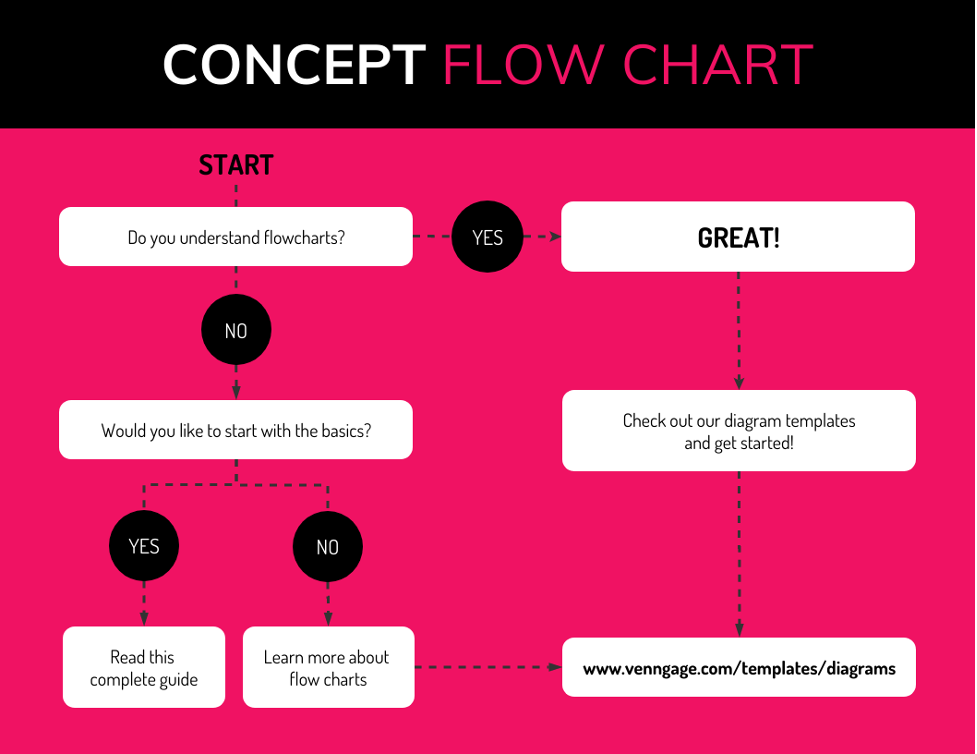Are you looking for a way to explain complex philosophical ideas in an easy and fun way?
Flowcharts can help.
Flowchart philosophy is a growing form of expression that uses the standardized symbols and shapes of flowcharts to visually convey abstract concepts. They also make great conversation starters! Here are some tips on how to create your own flowchart philosophy.

1. Know The Basics Of Flowchart-Making
Convey your philosophical thoughts with a flow chart maker usingh standard symbols and layout. The basic shapes, lines, arrows, boxes, stars, and text boxes are the symbols often included when using a flow chart maker. Any more than that can make your diagram confusing to readers.
After learning the basics, go to Venngage for a user-friendly and simple flow chart maker experience.
2. Aim For Clarity And Simplicity.
When you’re trying to explain a philosophical concept in words, accuracy is important, but when conveying the same idea visually, detail can be a bad thing. Make sure your layout in the free flow chart maker makes sense and stays clear at all times – use layering, color coding and other visual techniques to make sure that your flowchart remains understandable even if you have a lot going on.
3. Know Your Target Audience
If you are using an online flow chart maker for an overtly philosophical work, chances are that everyone who reads it will have a basic understanding of the concepts you’re discussing. However, for flowcharts trying to explain everyday ideas or social theories, clarity is key – even if you simplify the content, make sure that what your flowchart says is still clear.
4. Remember The Big Picture
This is especially important when using a flow chart diagram maker on something subtle and somewhat complicated: you need to be mindful of what your idea represents, and not just how it looks. This will help you avoid using too many visual cues that can get in the way of your flowchart’s meaning.
5. Make Your Philosophy Clear
Flowcharts are useful in part because they’re easy to understand, but if your chart is too simple it could give the wrong impression about a concept. Make sure your audience will get the message from what they see in what you’ve created with a flow chart maker online.
6. Get Your Thoughts In Order
Make sure that each idea flows from one another and doesn’t interrupt the flow of your diagram with unnecessary information or nonsensical connections.
7. Use Colors As Accent Marks
Using colors as a theme is too difficult for readers to follow along, so try not to do it. Using colors as accent marks is the best way to go, because this will allow your thoughts to stand out more.
8. Edits Are Okay!
Your thoughts about life might change every day, and that’s okay! If you find a better way to convey your ideas, make changes and update your flowchart.
9. Make Flowcharts As Conversation Starters!
They’re great ways to entertain your friends and family, especially during parties! Not only this, but they are also great icebreakers if you are looking to meet strangers. By drawing out flowcharts on the spot, you are able to spark up conversations with people who share your interests.
10. Be Creative!
Flowcharts don’t have to just be colorful diagrams filled with arrows and stars. Sometimes it’s fun to break the rules of the standard format and experiment with different styles. Try using photographs! You can use them to convey your ideas or just have them there as a decoration.
11. Don’t Be Afraid To Get Political
Flowcharts provide an excellent way for people to share their political opinions without any fear of censorship because they are presented in a fun and familiar way.
12. Combine Flowcharts
If you are ever stuck on what to write, think of ways to combine flowcharts with other artistic forms like poetry or music. It’ll make the experience much more engaging for your readers!
13. Check Other Flowcharts Online
If you are still stuck, check out some flowcharts online! There’s something for everyone, so take your time and explore what the world of flowchart philosophy has to offer.
14. Have Fun!
Flowcharts are supposed to be fun! Making one should be enjoyable, so don’t force yourself if you don’t feel like it. If you are not having fun making your flowchart, then there must be something wrong with the topic that you’re trying to convey or how it’s being conveyed. Play around with styles until you find the one that’s right for you!
Flowchart philosophy is about having fun and learning at the same time. Don’t take yourself too seriously! Try to make your flowchart humorous or convey serious ideas in a less formal manner. Good luck!
15. Complex Flowcharts Are Okay
Last but not least, don’t be afraid to make your philosophical process flow diagram complex! Flowcharts are a great way to visualize and understand abstract ideas. If you find yourself getting bored with the basic shapes and lines, why not try using different colors for each connection? Using more complicated diagrams will engage readers and provide a deeper understanding of your ideas.
In Conclusion
The way you think about the world is a philosophy, whether you realize it or not. Your philosophy can be complex and well thought out, or it can be full of contradictions and unanswered questions. If your goal is to improve how you understand the world around you, then one important step in doing so is making a flowchart of your philosophical beliefs.





